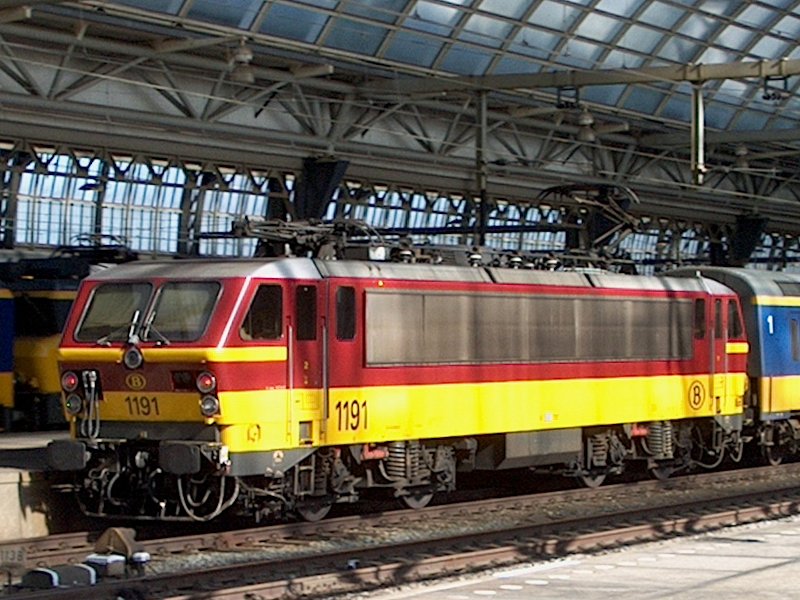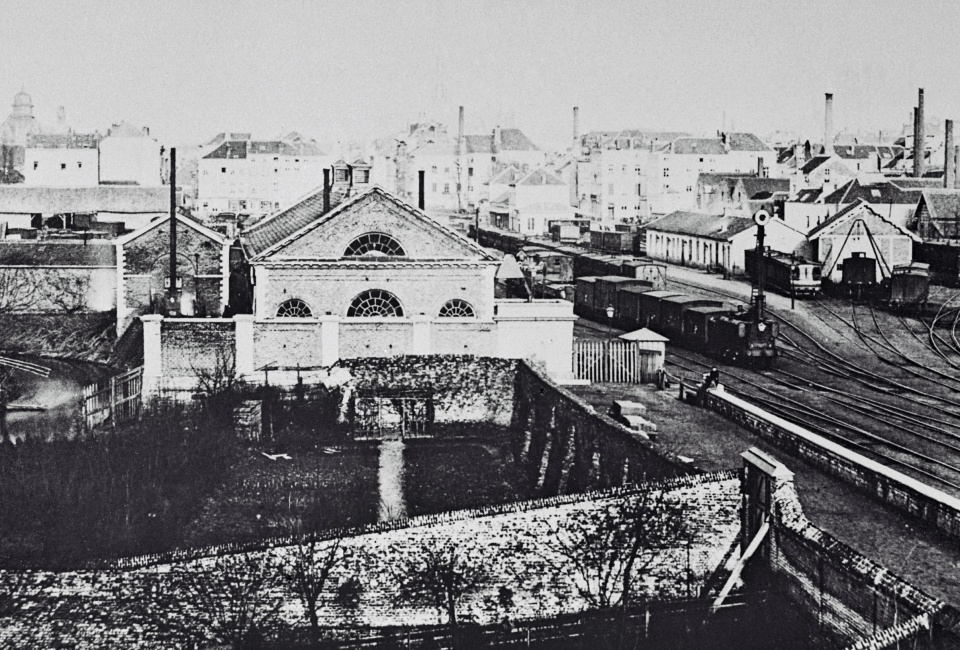|
Belgian State Railways Type 10
The Belgian State Railways Type 10, later known as the NMBS/SNCB Type 10, was a class of steam locomotives built between 1910 and 1914. The class was used to work express trains operated by the Belgian State Railways and its successor, the National Railway Company of Belgium (NMBS/SNCB), which was established in 1926. The locomotives were noteworthy for their unusually short boiler, which ended behind all four cylinders. This was due to the class sharing the boiler design with the Type 36 2-10-0 freight design, and the 2-10-0's weight limitations determined the length of the boiler. There were two sub-types of the Type 10" *The first 29 engines were the most powerful; they mostly ran over hilly main lines, including the tough between Brussels, Namur, Arlon and Luxembourg City *The last 29 were slightly lighter and had a smaller firebox; they were intended for easier lines, including the level line between Brussels and Ostend. Despite these differences, the last sub-typ ... [...More Info...] [...Related Items...] OR: [Wikipedia] [Google] [Baidu] |
John Cockerill (company)
John Cockerill, formerly Cockerill Maintenance & Ingénierie (CMI), is a mechanical engineering group headquartered in Seraing, Belgium. It produces machinery for steel plants, industrial heat recovery equipment and boilers, as well as shunting locomotives and military equipment. History In 1817, an iron foundry was established in Seraing by John Cockerill and his brother, Charles James Cockerill. As well as creating an iron works, John Cockerill also began machine-building activities, following in the footsteps of his father, William Cockerill, who had made his fortune constructing machines for the textile industry in the Liège region. In 1825, the enterprise became known as John Cockerill & Cie. The company produced the primary industrial machinery of the day – steam engines, blast furnace blowers, etc. In 1835, the company produced the first Belgian steam locomotive, '' Le Belge'', beginning a tradition of building locomotives for the railways of Belgium. An associatio ... [...More Info...] [...Related Items...] OR: [Wikipedia] [Google] [Baidu] |
ACFI Feedwater Heater
A feedwater heater is a power plant component used to pre-heat water delivered to a steam generating boiler. Preheating the feedwater reduces the irreversibilities involved in steam generation and therefore improves the thermodynamic efficiency of the system.Fundamentals of Steam Power by Kenneth Weston, This reduces plant operating costs and also helps to avoid to the boiler metal when the feedwater is introduced back into the steam cycle. In a steam power plant (usually modeled as a modified |
L&YR 2-10-0 (Hughes)
The L&YR 2-10-0 was a prospective design for a class of 2-10-0 steam locomotives on the Lancashire and Yorkshire Railway. Initial designs were made by George Hughes between 1913 and 1914, but none of the class were built. If they had been, these would have been the UK's first 10-coupled locomotives in regular service. Background Locomotives with ten driving wheels were rare in British railway history. One specialist exception, the GER Decapod, had been built in 1902, but the main heavy mineral locomotive design was the 0-8-0, on both the L&YR and the LNWR. Train weights were increasing though and there was some demand for a more powerful locomotive, particularly for the steep gradients across the Pennines from the Lancashire Coalfield to the port of Goole. It was felt that a more powerful single locomotive would avoid the need for double-heading on coal trains. In August 1913, John Aspinall was on holiday in the spa and railway town of Bad Homburg, Germany. Impressed by the ... [...More Info...] [...Related Items...] OR: [Wikipedia] [Google] [Baidu] |
Rail Transport In Belgium
Belgium has an extensive rail network. It is a member of the International Union of Railways (UIC). The UIC Country Code for Belgium is 88. History On May 5, 1835, the first railway in continental Europe opened between Brussels-Groendreef/Allée verte and Mechelen. Some sort of railroad or canal had been envisaged as early as 1830. The feasibility of a railroad was investigated by engineers Pierre Simons and Gustave De Ridder. The first trains were Stephenson engines imported from Great Britain. The engines were called ''Pijl'' meaning Arrow, ''Olifant'' meaning Elephant, and 'Stephenson' (named after its designer). They pulled bench-cars and diligences. On the return from Mechelen, the ''Olifant'' pulled all 30 cars. By 1840, Ghent, Bruges, Ostend, Antwerp, Mechelen, Brussels and Leuven were connected. The lines that had to reach Liège, Mons and Kortrijk were partially completed. In 1843, when the major East-West/North-South axes were complete, private companies were allowed t ... [...More Info...] [...Related Items...] OR: [Wikipedia] [Google] [Baidu] |
List Of SNCB/NMBS Classes
This is a list of NMBS/SNCB locomotive classes, classes of locomotive operated by the National Railway Company of Belgium: Multi-system electric locomotives Single-system electric locomotives Diesel locomotives The class 77 are used both as line engines in up to triple units for freight trains, and as shunting engines (see below). Commutation between operation at 100 km/h maximum (line) and 60 km/h maximum (shunting) can be done while the locomotive is halted. Diesel shunting locomotives Electric Multiple Units Diesel Multiple Units Steam locomotives *SNCB Type 1 — 4-6-2 * SNCB Type 7 — 4-6-0 * SNCB Type 10 – 4-6-2 *SNCB Type 12 — 4-4-2 * SNCB Type 16 – 2-6-0 * SNCB Type 17 - 4-4-0 * SNCB Type 25 – 0-6-0 * SNCB Type 26 – 2-10-0 * SNCB Type 29 – 2-8-0 * SNCB Type 36 – 2-10-0 * SNCB Type 53 – 0-8-0T * SNCB Type 58 – 0-6-0T *SNCB Type 64 – 4-6-0 * SNCB Type 81 – 0-8-0 * SNCB Type 98 – 0-10-0T See also *History of r ... [...More Info...] [...Related Items...] OR: [Wikipedia] [Google] [Baidu] |
History Of Rail Transport In Belgium
Belgium was heavily involved in the early development of railway transport. Belgium was the second country in Europe, after Great Britain, to open a railway and produce locomotives. The first line, between the cities of Brussels and Mechelen opened in 1835. Belgium was the first state in Europe to create a national railway network and the first to possess a nationalised railway system. The network expanded fast as Belgium industrialised, and by the early 20th century was increasingly under state-control. The nationalised railways, under the umbrella organisation National Railway Company of Belgium (NMBS/SNCB), retained their monopoly until liberalisation in the 2000s. Background Attempts to build railways in Belgium significantly predated the establishment of the first line. In 1829, the British-Belgian industrialist John Cockerill tried to obtain a concession from the Dutch king William I to build a railway line from Brussels to Antwerp, without success. Shortly after the in ... [...More Info...] [...Related Items...] OR: [Wikipedia] [Google] [Baidu] |
Train World
Train World is a railway museum in Brussels, Belgium, and the official museum of the National Railway Company of Belgium. It is situated in the preserved buildings of Schaarbeek railway station and in a new shed built to its north. Although scheduled to open in 2014, its opening was delayed until September 2015. The Museum was solemnly opened by King Philippe. Overview The museum is over and displays 22 locomotives. It also displays 1,200 other objects, including an original 19th century railway bridge. One of the most important objects in the museum is the " Pays du Waes" locomotive, dating to 1845, which is the oldest preserved locomotive in Continental Europe. Collection The preserved railway materials which are exhibited in the national museum in Schaarbeek (Brussels) The following materials are on display (definitively) in the National Museum in Schaerbeek (Brussels) : In addition, a set of steam and diesel locomotives, railcars, electric railcars, coaches and wagons a ... [...More Info...] [...Related Items...] OR: [Wikipedia] [Google] [Baidu] |
Brussels-South Railway Station
Brussels-South railway station (french: Gare de Bruxelles-Midi, nl, Station Brussel-Zuid, IATA code: ZYR), officially Brussels-South (french: Bruxelles-Midi, link=no, nl, Brussel-Zuid, link=no), is a major railway station in Brussels, Belgium. Geographically, it is located in Saint-Gilles/Sint-Gillis on the border with the adjacent municipality of Anderlecht and just south of the City of Brussels. Brussels-South is one of over a dozen railway stations in Brussels, and one of the three principal rail stations in the heart of the city, the two others being Brussels-Central and Brussels-North. The station, which was a terminus when it was inaugurated in 1869, became a transit station with the opening of the North–South connection in 1952. Nowadays, it is the busiest station in Belgium, and is the only Brussels stop for international high-speed rail services: Eurostar, Thalys and ICE. Underneath Brussels-South is the rapid transit / station on lines 2, 3, 4 and 6 of th ... [...More Info...] [...Related Items...] OR: [Wikipedia] [Google] [Baidu] |
2-8-2
Under the Whyte notation for the classification of steam locomotives, represents the wheel arrangement of two leading wheels on one axle, usually in a leading truck, eight powered and coupled driving wheels on four axles and two trailing wheels on one axle, usually in a trailing truck. This configuration of steam locomotive is most often referred to as a Mikado, frequently shortened to Mike. At times it was also referred to on some railroads in the United States of America as the McAdoo Mikado and, during World War II, the MacArthur. The notation 2-8-2T indicates a tank locomotive of this wheel arrangement, the "T" suffix indicating a locomotive on which the water is carried in tanks mounted on the engine rather than in an attached tender. Overview The 2-8-2 wheel arrangement allowed the locomotive's firebox to be placed behind instead of above the driving wheels, thereby allowing a larger firebox that could be both wide and deep. This supported a greater rate of combustion ... [...More Info...] [...Related Items...] OR: [Wikipedia] [Google] [Baidu] |
SNCB Type 5
french: Société nationale des chemins de fer belgesgerman: Nationale Gesellschaft der Belgischen Eisenbahnen , type = Statutory corporation , industry = Rail Transport , foundation = 1926 , founder = Government of Belgium , location = Avenue de la Porte de Hal/Hallepoortlaan 40 , location_city = 1060 Brussels , key_people = , products = Rail Transport , revenue = €2.296.6 billion (2012) , operating_income = €6.306,5 million (2012) , net_income = € -152.3 million (2012) , num_employees = 34,000 (2016) , parent = , subsid = BeNe Rail EurogareTrain World (BE) SNCB YPTO , location_country = Belgium , homepage = , foot_notes = The National Railway Company of Belgium ( nl, Nationale Maatschappij der Belgische Spoorwegen, or NMBS; french: Société nationale des chemins de fer belges, or SNCB; german: Nationale Gesellschaft der Belgischen Eisenbahnen) ... [...More Info...] [...Related Items...] OR: [Wikipedia] [Google] [Baidu] |
SNCB Type 1
The NMBS/SNCB Type 1 was a class of steam locomotives built in 1935 and 1938 for working heavy express passenger trains operated by the National Railway Company of Belgium (NMBS/SNCB). Design, construction and service history Thirty five type 1 locomotives were built by the Société Anonyme la Métallurgique at its Tubize factory. They had a high degree of superheat, and a firebox that was so wide, it had two firehole doors. The members of the class were retired in 1962. One locomotive, no. 1.002, has been preserved by the NMBS/SNCB. It is displayed at the Treignes railway museum of heritage railway CFV3V (Chemin de fer à vapeur des trois vallées) in the far south of Belgium. References * * * External links 4-6-2 locomotives National Railway Company of Belgium locomotives, 01 Railway locomotives introduced in 1935 Steam locomotives of Belgium, Type 01 Standard gauge locomotives of Belgium 2′C1′ h4 locomotives {{steam-loco-stub ... [...More Info...] [...Related Items...] OR: [Wikipedia] [Google] [Baidu] |





